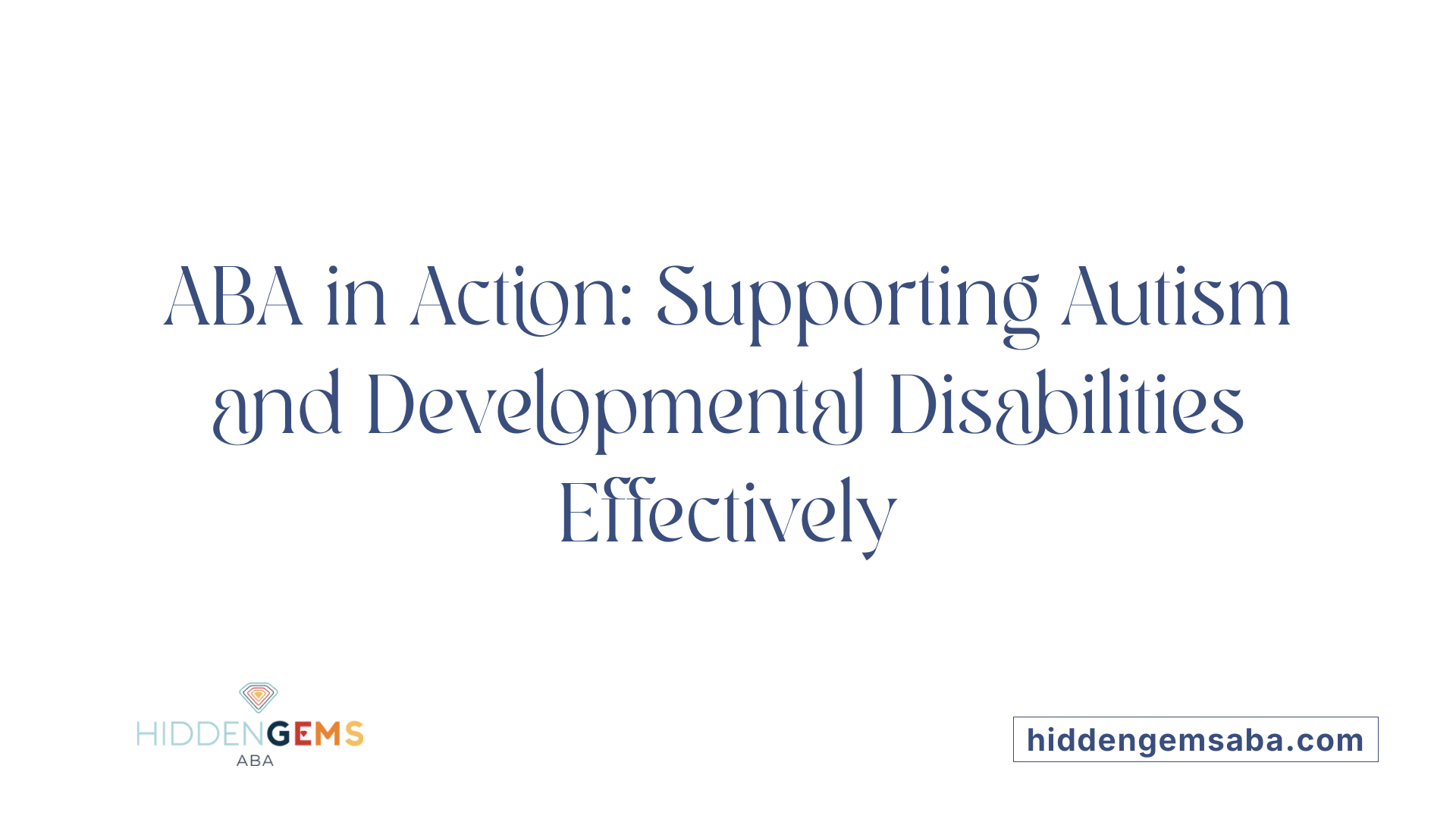Understanding ABA Therapy: A Science-Driven Approach to Behavior Change
Applied Behavior Analysis (ABA) is a scientifically grounded therapy that utilizes principles of learning to modify human behavior. Its evidence-based techniques and structured interventions have become the gold standard, especially in treating autism spectrum disorder and other developmental disabilities. This article explores the origins, principles, methods, applications, benefits, ethical considerations, and resources related to ABA therapy, providing a comprehensive overview of this influential discipline.
What is ABA Therapy and Its Scientific Foundations

What is applied behavior analysis (ABA)?
Applied Behavior Analysis (ABA) is an evidence-based therapy grounded in scientific principles of learning and behavior. It aims to understand how environmental factors influence actions and to systematically modify these behaviors through reinforcement and other techniques.
ABA involves analyzing the relationship between specific behaviors and the circumstances surrounding them. It uses tools like the ABC model, which examines Antecedents (what happens before a behavior), the Behavior itself, and Consequences (what follows the behavior). This approach helps identify triggers and outcomes that maintain or suppress behaviors.
Scientific basis of ABA
The foundation of ABA comes from behaviorist psychology, particularly the theories of operant and respondent conditioning developed by psychologists like B.F. Skinner. These principles explain how behaviors can be learned, strengthened, or weakened through reinforcement, punishment, and other environmental factors.
Research has consistently supported ABA’s effectiveness, especially for children with autism spectrum disorder (ASD). Studies show that when applied intensively and early—often before age 4—ABA can lead to meaningful, lasting improvements in communication, social skills, and adaptive behaviors.
Assessment and personalized treatment plans
When starting ABA therapy, a trained professional, usually a Board Certified Behavior Analyst (BCBA), conducts a comprehensive assessment, including functional behavior assessments to understand the purpose of specific behaviors.
Based on this assessment, the BCBA develops a customized treatment plan tailored to the individual's needs, strengths, and interests. Goals may include enhancing language, social skills, self-care, academic skills, or reducing problematic behaviors.
The plan includes specific techniques, session structures, and benchmarks for progress, which are regularly reviewed and adjusted as the child develops.
Key behaviors targeted in ABA
ABA therapy focuses on socially significant behaviors such as communication, social interaction, academic skills, and independence. It also aims to reduce harmful behaviors like self-injury, tantrums, or aggression.
Through systematic teaching and reinforcement, children learn new skills and behaviors that support their participation and success in daily life. The ultimate goal is to foster independence, improve quality of life, and help children adapt to various environments.
Core Principles and Techniques of ABA

What are the principles and techniques used in ABA therapy?
Applied Behavior Analysis (ABA) therapy is grounded in foundational principles such as reinforcement, prompting, fading, modeling, and behavior chaining. These methods are designed to bring about meaningful changes in behavior by understanding the functions of specific actions and systematically modifying the environment.
Reinforcement plays a pivotal role in ABA, as it involves rewarding desirable behaviors to encourage their repetition. Prompting and fading are strategies used to initiate new skills; prompts assist the child in performing a task correctly, while fading gradually reduces the prompts to promote independence.
Other common techniques include modeling, where the therapist demonstrates the desired behavior for the child to imitate, and visual supports like the Picture Exchange Communication System (PECS). Behavior chaining involves linking individual behaviors into a sequence to achieve a complex skill.
ABA therapy uses the ABC model—Antecedent, Behavior, and Consequence—to analyze behavioral patterns. Antecedents are triggers or cues that lead to a behavior, which is then followed by a consequence that reinforces or discourages that behavior. This model helps therapists identify triggers and modify the environment to support positive behavior change.
Importantly, ABA plans are tailored to each individual. Board Certified Behavior Analysts (BCBAs) develop personalized programs based on thorough assessments, ensuring interventions are relevant and effective.
The approach emphasizes natural learning environments, enabling children to acquire skills in real-life contexts. Social interactions and generalization—applying learned skills across different settings—are central to maximizing therapy effectiveness.
Numerous studies support the scientific validity of ABA, showing it to be effective in teaching essential skills, reducing harmful behaviors, and promoting independence. When implemented correctly, ABA can significantly improve communication, social skills, and daily functioning, helping children participate more fully in society.
Applications in Autism and Developmental Disabilities
 ABA therapy is widely used to support individuals with autism spectrum disorder (ASD) and other developmental disabilities. Its primary goal is to foster positive behaviors while reducing problematic or harmful ones. The approach relies on a variety of evidence-based techniques, including positive reinforcement, structured instruction, and naturalistic teaching methods, all tailored to each individual's needs.
ABA therapy is widely used to support individuals with autism spectrum disorder (ASD) and other developmental disabilities. Its primary goal is to foster positive behaviors while reducing problematic or harmful ones. The approach relies on a variety of evidence-based techniques, including positive reinforcement, structured instruction, and naturalistic teaching methods, all tailored to each individual's needs.
One of the main strategies includes Discrete Trial Training (DTT), which involves highly structured, one-on-one sessions that break skills into small, manageable steps. This technique promotes learning through repeated practice and reinforcement. Another popular method is Pivotal Response Treatment (PRT), which is more naturalistic and play-based, encouraging children to learn through their interests and interactions in natural environments.
Trained professionals like Board Certified Behavior Analysts (BCBAs) and registered behavior technicians (RBTs) play crucial roles. BCBAs oversee individualized treatment plans developed after thorough assessments, ensuring interventions are effective and ethically applied. They supervise therapy sessions, analyze data, and make adjustments to maximize progress.
The overarching goals of ABA are to increase independence and social participation. This includes improving communication skills, social interactions, self-care, academic skills, and motor abilities. Interventions are personalized, focusing on a child's strengths and specific challenges to promote meaningful and long-lasting improvements.
Additionally, ABA programs are typically intensive, often involving several hours per week over multiple years. This consistency helps children develop new skills and maintain progress across different settings. By emphasizing measurable outcomes and scientific principles, ABA remains a cornerstone of autism intervention, supporting children to reach their full potential and participate more fully in everyday life.
Benefits and Efficacy of ABA
 Applied Behavior Analysis (ABA) has demonstrated significant positive outcomes for individuals with autism and other developmental disorders. One of its main benefits is the improvement in communication and social skills, helping children and adults interact more effectively and participate in everyday activities with greater independence. ABA also aids in reducing challenging behaviors, such as self-injury, tantrums, and disruptive conduct, making daily life safer and more manageable.
Applied Behavior Analysis (ABA) has demonstrated significant positive outcomes for individuals with autism and other developmental disorders. One of its main benefits is the improvement in communication and social skills, helping children and adults interact more effectively and participate in everyday activities with greater independence. ABA also aids in reducing challenging behaviors, such as self-injury, tantrums, and disruptive conduct, making daily life safer and more manageable.
Research consistently supports the effectiveness of ABA, especially when interventions are initiated early, are intensive, and involve regular sessions. For optimal results, starting therapy before age six and maintaining a consistent schedule—often several hours per week—yields noticeable improvements in language development, social engagement, and adaptive skills. Studies have shown that individuals receiving early and sustained ABA interventions can experience long-term benefits, including better academic performance and greater independence.
The scientific backing of ABA solidifies its status as a gold-standard treatment in autism intervention. High-quality research indicates that these programs not only foster skill acquisition but also generalize learned behaviors across different environments and situations. This transferability is vital for ensuring that gains are maintained and applied in real-world settings, ultimately improving quality of life.
Overall, ABA offers a structured, evidence-based approach with a strong track record of promoting meaningful, lasting changes. Its focus on positive reinforcement and tailored goals makes it a comprehensive method for supporting individuals on the autism spectrum in achieving greater social and functional independence.
Historical Development and Ethical Considerations

What is the history and development of ABA as a discipline?
Applied Behavior Analysis (ABA) began as a formal discipline in the early 20th century, rooted in the principles of behaviorist psychology. Pioneers like John B. Watson, known for establishing behaviorism, laid the groundwork by emphasizing observable behaviors and environmental influences. Later, B.F. Skinner expanded on these ideas, developing operant conditioning theories that explained how behaviors are learned and maintained.
The field gained significant momentum in the 1960s with Ole Ivar Lovaas’s groundbreaking work. He designed intensive and structured behavioral interventions aimed at children with autism, leading to remarkable improvements in communication, social interactions, and adaptive skills. His approach demonstrated that systematic behavior modification could produce lasting changes.
Over the decades, ABA evolved from its early, rigid methods—often involving adult-led, highly structured tasks—to include more naturalistic and child-centered techniques. This shift emphasized reinforcement, engagement, and meaningful integration into everyday activities, making therapy more adaptable and respectful of individual needs.
Today, ABA is a comprehensive framework used across diverse populations, including those with autism and other developmental disorders. It relies heavily on scientific evidence, with continuous research validating its effectiveness. Modern standards focus on positive reinforcement, personalization, and ethical practices, emphasizing respect for neurodiversity and individual rights.
While ABA’s success has been well-documented, ongoing discussions about its ethical application—such as avoiding punishment, promoting autonomy, and respecting neurodiverse perspectives—shape its continuous refinement. As a discipline, ABA now balances scientific rigor with humane, supportive interventions that aim to empower individuals and foster meaningful participation in society.
Professional Certification and Ethical Practice

Roles of BCBAs and RBTs
Board Certified Behavior Analysts (BCBAs) and Registered Behavior Technicians (RBTs) are essential in delivering ABA therapy. BCBAs often oversee treatment plans, conduct assessments, and supervise therapy, while RBTs implement daily intervention strategies under the BCBA’s guidance. Both roles require specific training and certification to ensure ethical and effective practice.
Certification Requirements (Master’s Degree, Supervision, Exam)
To become a BCBA, candidates must hold a master’s degree in behavior analysis, psychology, or a related field. They must complete supervised clinical hours—typically around 2,000 hours—and pass a comprehensive exam administered by the Behavior Analyst Certification Board (BACB). RBTs also need to complete a training program, pass a competency assessment, and adhere to ongoing continuing education.
Verifying Credentials via Organizations Like BACB
Consumers seeking ABA services should verify practitioners' credentials through recognized organizations. The BACB maintains a public directory of certified professionals, including BCBAs, BCaBAs, and RBTs. This verification ensures the practitioner has met the rigorous standards for competence and ethical practice.
Ethical Standards and Ongoing Education
Certified behavior analysts are bound by professional ethical standards set by the BACB. These standards emphasize client welfare, confidentiality, and integrity. Practitioners are also required to pursue ongoing education to stay current with research developments, which supports safe, effective, and evidence-based interventions.
Importance of Choosing Qualified Practitioners
Selecting qualified ABA practitioners is crucial to ensure safe and effective treatment. Certified professionals operate within a code of ethics and follow scientifically-supported practices. Parents and guardians should verify credentials, review the practitioner’s experience, and confirm ongoing supervision to guarantee quality care.
How can one find qualified ABA practitioners and certifications?
To find qualified ABA practitioners and certifications, start by consulting recognized organizations such as the Behavior Analyst Certification Board (BACB) and Qualified Applied Behavior Analysis Credentialing Board (QABA). These organizations provide directories of certified professionals and details about their credentials. Ensure practitioners hold appropriate licenses like BCBA, BCaBA, or RBT, and verify these credentials via the agencies’ websites. Referrals from healthcare providers, local support groups, or parent networks can also help locate reputable therapists. When choosing a provider, ask about their experience with similar cases, verify their qualifications, and ensure they participate in ongoing supervision and continuing education. Many certifying organizations offer tools to verify credentials and ensure practitioners meet professional standards.
Controversies, Criticisms, and Ethical Standards in ABA

What are some criticisms and controversies surrounding ABA therapy?
Critics of ABA therapy often point to its historical use of punishment and aversive techniques, such as electric shocks, which have since been abandoned in favor of more positive strategies. These past methods are now widely recognized as unethical and harmful, leading to significant debate about the therapy's legacy.
Modern ABA places a strong emphasis on humane, positive reinforcement-based practices. It prioritizes individualized treatment plans that focus on building skills and encouraging desirable behaviors without causing distress. The shift to positive reinforcement has improved the approach significantly, but concerns still remain.
One major source of controversy involves the neurodiversity movement. Many autistic self-advocates argue that traditional ABA often seeks to make autistic children appear more neurotypical by suppressing natural behaviors like stimming or self-expression. Critics claim this focus can diminish personal identity, dismiss sensory needs, and promote conformity over acceptance.
There is also concern about the potential risks of overly rigid or repetitive interventions. Some worry that strict applications may cause stress, frustration, or trauma, especially if the child is not engaged or feels coerced. These issues highlight the importance of respectful, flexible, and play-based strategies.
Emerging debates focus on ethical practice and autonomy. Critics call for greater transparency and informed consent, emphasizing respect for children’s preferences and comfort. The goal is to balance skill development with respecting individual differences.
Efforts are underway to make ABA more respectful and tailored to each child's needs. This includes incorporating family input, focusing on positive experiences, and ensuring interventions support the child’s well-being. As the field advances, ongoing dialogue continues about ethical standards, the potential for harm, and how best to serve autistic individuals with dignity.
Resources, Education, and Career Opportunities in ABA

What resources are available for learning about ABA and behavior analysis?
The field of Applied Behavior Analysis (ABA) offers a wealth of educational resources suitable for beginners and professionals alike. Notable among these are online platforms that host webinars, videos, articles, and podcasts dedicated to ABA principles and applications. Organizations like the Association for Behavior Analysis International (ABAI) and the Society for the Advancement of Behavior Analysis provide access to a multitude of materials, including research summaries, technical reports, and practitioner guidelines.
Academic journals are critical for those interested in scientific findings supporting ABA; these peer-reviewed publications feature studies on therapies, techniques, and outcomes. Books authored by experts, including foundational texts by Ole Ivar Lovaas and contemporary guides, offer comprehensive insight into behavior analytic methods.
Professional organizations such as the Behavior Analyst Certification Board (BACB) are invaluable for understanding certification processes, ethical standards, and best practices. Websites like Autism Speaks and the Autism Society of America also deliver accessible educational content, downloadable resources, and unbiased information, aiding families and caregivers to better understand ABA’s applications. Collectively, these resources facilitate lifelong learning, promote ethical practice, and support professional development in behavior analysis.
What are career opportunities related to ABA therapy?
A variety of career paths are available within the field of ABA, ranging from direct clinical practice to research and management. Entry-level roles include Behavior Therapist and Registered Behavior Technician (RBT), where practitioners implement behavior intervention plans under supervision, often working with children on the autism spectrum.
For those seeking advanced positions, the Board Certified Behavior Analyst (BCBA) credential is highly regarded. BCBAs develop, oversee, and evaluate individualized intervention programs, ensuring they adhere to scientific standards and ethical guidelines. The BCBA-D is a doctoral-level certification for experts involved in higher-level program design, research, and policy advocacy.
Outside direct therapy, ABA expertise opens opportunities in education as special education teachers and classroom behavior specialists. Healthcare professionals, such as clinical therapists and addiction counselors, also utilize ABA techniques. Career prospects extend into research, program management, and public policy, especially in organizations dedicated to developmental disabilities.
In addition to clinical settings, many ABA practitioners work in private clinics, schools, and hospitals, with promising job growth and competitive salaries. The versatility of ABA skills also enables professionals to branch into fields like organizational behavior management, sports performance, animal training, and community health initiatives.
Job growth and industrial demand
The demand for qualified ABA professionals continues to escalate, driven by increased awareness of autism spectrum disorder and the proven effectiveness of ABA interventions. The U.S. Bureau of Labor Statistics projects strong growth for behavior analysts, with employment opportunities expanding across various settings. This demand correlates with the emphasis on early intervention, insurance coverage, and school-based services.
This expanding industry underscores the importance of ongoing professional development, as new research, techniques, and ethical standards regularly emerge. Certification renewal, advanced training, and participation in conferences help practitioners stay current and enhance their efficacy.
Importance of ongoing professional development
Advancing in the field of ABA requires continuous education to maintain certification and stay abreast of scientific developments. Professional organizations like the BACB offer workshops, courses, and conferences providing opportunities for skill enhancement.
Attending seminars on emerging techniques like Naturalistic Developmental Behavioral Interventions (NDBI) or telehealth practices allows practitioners to expand their toolkit and improve service quality. Pursuing postgraduate degrees, such as a Master of Science or doctoral programs in behavior analysis or related fields, further deepens expertise.
Engagement in research projects and publishing findings contribute to the scientific advancement of ABA and solidify a practitioner's authority in the field. Through these ongoing efforts, professionals ensure their practices remain effective, ethical, and aligned with best standards.
| Resource Type | Examples | Benefits |
|---|---|---|
| Educational Platforms | ABAI, Society for the Advancement of Behavior Analysis | Access to webinars, podcasts, and articles |
| Scholarly Journals | Journal of Applied Behavior Analysis, Behavior Analysis | Peer-reviewed research supporting ABA techniques |
| Books | "Applied Behavior Analysis" by Cooper et al., and others | In-depth understanding, historical context, and practical guides |
| Professional Organizations | Behavior Analyst Certification Board (BACB), Autism Society | Certification info, code of ethics, practice standards |
| Conferences & Workshops | BACB conferences, regional ABA meetings | Networking, latest research, practical skills |
| Career Path | Role | Requirements | Typical Settings |
|---|---|---|---|
| Behavior Therapist | Implement behavior plans | RBT certification, supervised experience | Homes, clinics, schools |
| Registered Behavior Technician | Assist with ABA interventions | RBT credential | Autism centers, community programs |
| Board Certified Behavior Analyst | Develop and oversee treatment plans | Master’s degree, BCBA certification | Private practice, hospitals, research institutions |
| Researcher | Study behavioral processes | PhD in behavior analysis or related field | Universities, research labs |
| Educator | Teach ABA techniques in schools or training programs | Teaching license, ABA training | Schools, training centers |
The expanding nature of ABA and its scientific basis ensure it remains a vital part of behavioral health and education. Whether pursuing certification, engaging in research, or applying ABA principles directly, professionals find numerous opportunities for growth and contribution in this dynamic field.
The Future of ABA: Advancing Practice with Ethical and Scientific Rigor
As ABA continues to evolve, it maintains its position as a scientifically validated approach to behavior change that can profoundly impact lives. Emphasizing individualized, humane, and culturally respectful practices, the discipline aims to support the growth of individuals across the lifespan. With ongoing research, ethical standards, and expanding resources for practitioners and families, ABA remains a cornerstone in behavioral health, offering new opportunities for effective intervention, professional development, and societal acceptance.
References
- Applied Behavior Analysis (ABA) | Autism Speaks
- Applied Behavior Analysis (ABA) - Cleveland Clinic
- Applied Behavior Analysis - dds.ca.gov
- Applied Behavior Analysis: What Is It and How Does It Work? - WebMD
- Applied Behavior Analysis - Psychology Today
- Applied behavior analysis - Wikipedia
- Behavioral Treatment of Autism and Other Developmental ... - BACB
- What Is Applied Behavior Analysis - Exploring ABA Therapy Careers
- The Controversy Around ABA - Child Mind Institute
- Applied behavior analysis treatment of autism: the state of the art





